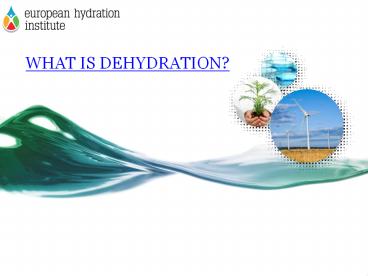What is dehydration? - PowerPoint PPT Presentation
Title:
What is dehydration?
Description:
Dehydration occurs when the body loses more water than is taken in. It is often accompanied by disturbances in the body's mineral salt or electrolyte balance - especially disturbances in the concentrations of sodium and potassium. – PowerPoint PPT presentation
Number of Views:7862
Title: What is dehydration?
1
- WHAT IS DEHYDRATION?
2
Dehydration is the loss of water from the body
in excess of the amount consumed.
Dehydration
- WHAT IS IT?
- Dehydration occurs when the body loses more water
than is taken in. It is often accompanied by
disturbances in the body's mineral salt or
electrolyte balance - especially disturbances in
the concentrations of sodium and potassium.
read more
3
HOW IS IT CAUSED?
- Mild dehydration is common and usually caused by
not drinking enough fluids throughout the day. In
children, diarrhoea is a common cause. read
more - CONSEQUENCES
- A loss of body water equivalent to about 1 of
body weight is normally compensated within 24
hours. Thirst stimulates drinking, so intake is
increased and there is also a reduction in water
loss by the kidneys. If losses are greater than
this, reductions in physical and cognitive
performance may occur and there may be some
impairment of thermoregulation and cardiovascular
function. read more
4
WHAT IS DEHYDRATION? (1)
- Dehydration occurs when the body loses more water
than is taken in. It is often accompanied by
disturbances in the body's mineral salt or
electrolyte balance - especially disturbances in
the concentrations of sodium and potassium. - Under typical circumstances the body loses and
needs to replace approximately 2 to 3 litres of
water daily. Breathing, urinating, defecating,
and perspiring all cause water losses that need
to be replaced on a daily basis. If water is lost
from the bloodstream, the body can compensate
somewhat by shifting water from cells into the
blood vessels, but this is a very short-term
solution. If the lost water is not replenished,
the body may suffer serious consequences.
5
WHAT IS DEHYDRATION? (2)
- The body is able to monitor the amount of water
it needs to function. The thirst mechanism
signals the body to drink when the body water
content is reduced. Hormones, including
anti-diuretic hormone (ADH), work with the kidney
to limit the amount of water lost in the urine
when the body needs to conserve water. Water
intake and output are highly variable but closely
matched to less than 0.1 over an extended period
through homeostatic control. Electrolyte intake
and output are also closely linked, both to each
other and to the hydration status. - Failure to match intake and loss of water and
minerals, especially sodium and potassium, may
lead to dehydration. Depending on the ratio of
water to electrolyte loss, dehydration can be
classified as isotonic, hypertonic or hypotonic
6
Isotonic dehydration
- Is characterised by isotonic loss of both water
and solutes from the extracellular fluid, that is
when both water and sodium are lost in equivalent
amounts, e.g. through vomiting, diarrhoea or
through inadequate intake. There is no osmotic
shift of water from the intracellular space to
the extracellular space. This type of dehydration
accounts for cases of dehydration in young
children.
7
Hypertonic dehydration
- In hypertonic dehydration water loss exceeds salt
loss, that is when more water than sodium is lost
(e.g. through inadequate water intake, excessive
sweating, osmotic diuresis and diuretic drugs).
This is characterised by an osmotic shift of
water from the intracellular fluid to the
extracellular fluid. This type of dehydration is
more common in people who have diabetes, and it
accounts for approximately 10 to 20 percent of
all paediatric cases of dehydration with
diarrhoea.
8
Hypotonic dehydration
- In hypotonic dehydration more sodium than water
is lost, e.g. in some instances of high sweat or
gastro-intestinal water losses or when water and
electrolyte deficits are treated with water
replacement only, it is characterised by an
osmotic shift of fluid from the extracellular
area to the intracellular. It also occurs with
excessive intakes of plain water or other liquids
with little or no sodium content. This type of
dehydration accounts for approximately 10 to 15
percent of all paediatric cases of dehydration
with diarrhoea. This complication can be
life-threatening if swelling causes pressure on
the brain (cerebral oedema). This is called
hyponatraemia.
9
Reminder
- WHAT IS DEHYDRATION?
- HOW IS DEHYDRATION CAUSED?
- CONSEQUENCES OF DEHYDRATION

